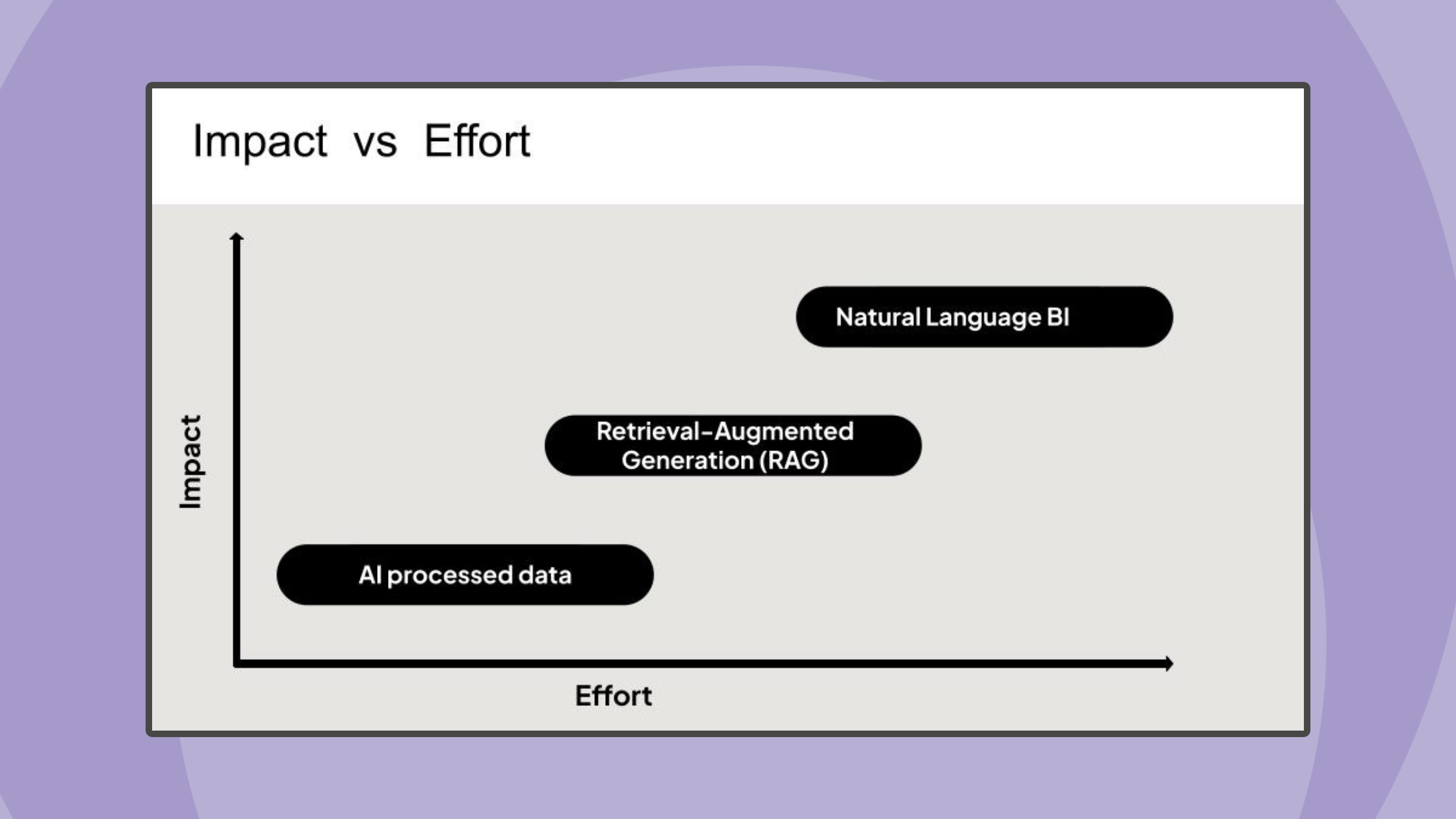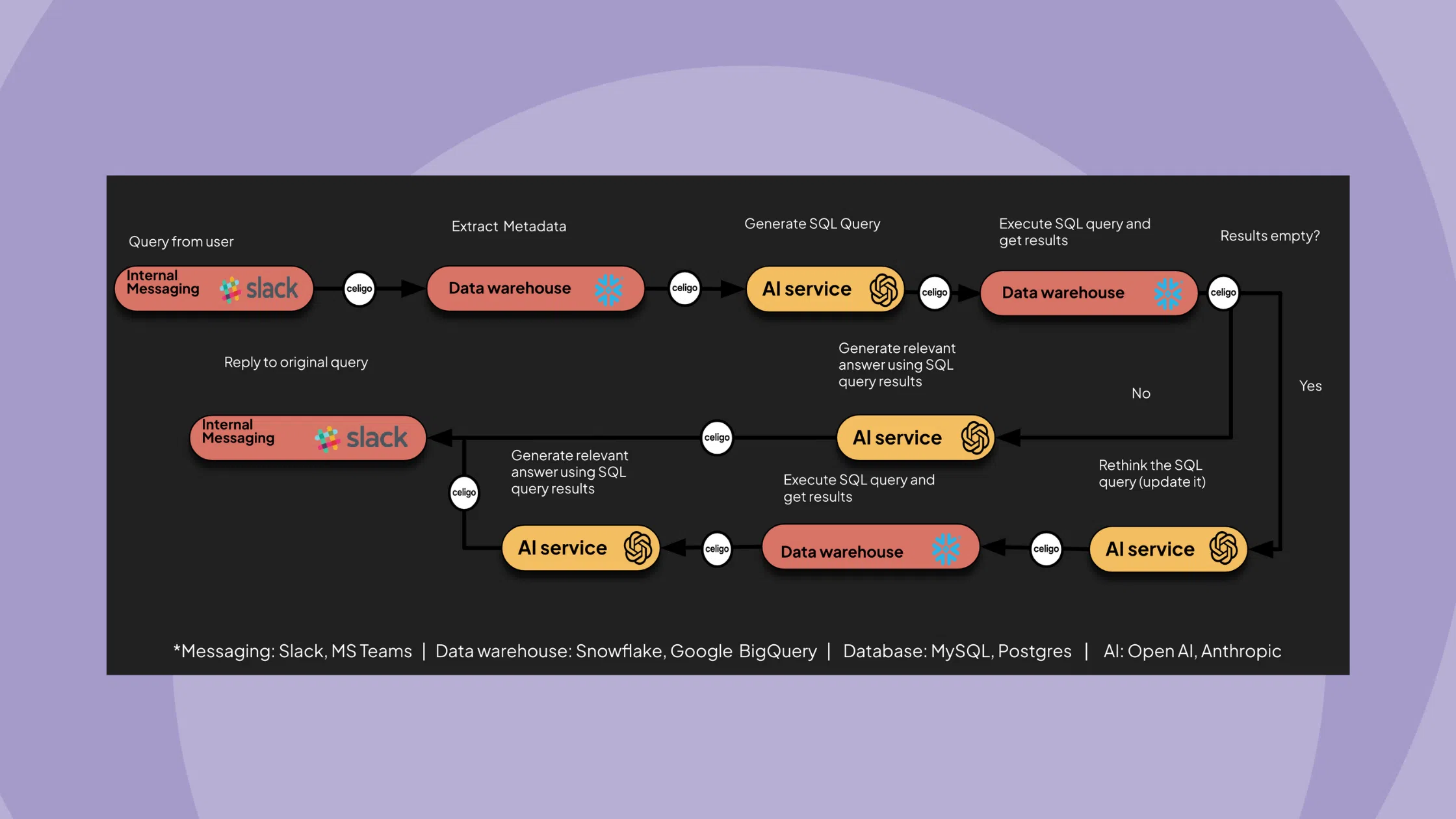Published Aug 28, 2024
AI use cases: Evaluating impact vs. effort

Integrating AI into business operations is more than just implementing tools. It requires a strategic and scalable framework to ensure that your AI initiatives are effective and capable of expansion. The cornerstone of this integration strategy is identifying the most relevant AI use cases. This critical selection process is essential for maximizing impact and efficiently managing the scope of implementation efforts. By focusing on these critical areas, businesses can adeptly navigate the intricacies of AI integration, maximizing impact while managing implementation efforts.
In our last two articles, we discussed developing an impactful AI strategy and examined AI business use cases, highlighting benefits across various industries.
Here, we’ll explore three AI use cases, each with unique benefits and varying implementation efforts, to understand how AI can be effectively utilized.
Join Youssef Zouhairi, a Solutions Consultant at Celigo, as he explores three AI use cases and assesses their impact versus effort.
In-depth look at three key AI use cases
1. AI-processed data
This use case leverages generative AI for tasks such as text summarization, classification, sentiment analysis, and entity extraction. It is particularly useful for processing unstructured data sources like customer reviews, emails, and social media posts, enabling businesses to derive actionable insights.
Example: Data summarization
Extract actionable insights from extensive datasets by integrating data sources, processing real-time information, and delivering concise summaries. This approach improves organizational knowledge-sharing and decision-making by providing stakeholders with timely and relevant information.
Designing new organizational knowledge-sharing. Build a conversational front-end knowledge bot using platforms like Slack or Teams. This bot can empower internal and external communities by providing instant, accurate responses, enhancing user experience, and streamlining information dissemination. The bot aggregates information from various sources to present a holistic view, thereby automating knowledge creation and sharing.
Benefits:
- Efficiency: Automates the analysis of large volumes of unstructured data.
- Insightful: Provides precise, actionable insights for different departments based on customer feedback.
- Scalable: Can handle increasing amounts of data without additional manual effort.
2. Retrieval-augmented generation (RAG)
RAG integrates large language models (LLMs) with proprietary data sources to deliver contextually relevant answers. It operates by retrieving specific context from a company’s internal data, enhancing it with the user’s query, and generating a precise response using the LLM.
Why RAG is necessary
LLMs like OpenAI’s Chat GPT are powerful but limited in their ability to access and utilize proprietary data. These models generate responses based on publicly available data and lack access to the specific internal knowledge crucial for many business scenarios.
RAG addresses this by integrating data from multiple sources, ensuring AI models receive comprehensive, context-rich information. By combining the general knowledge of LLMs with the specificity of a company’s internal data (stored in vector databases like Pinecone), RAG enables the generation of accurate, context-specific responses. Robust data transformation and real-time orchestration further enhance the accuracy and reliability of AI outputs, effectively overcoming the inherent limitations of LLMs.
Learn more about how an iPaaS facilitates data integration for RAG app development.
Benefits:
- Accuracy: Delivers precise, context-aware answers by leveraging proprietary data.
- Transparency: Provides sources for all AI-generated responses, building trust.
- Utility: Reduces the time spent searching for specific information within large datasets.
3. Natural language BI
Natural language BI allows non-technical business users to interact with structured data using natural language, eliminating the need for technical SQL skills.
By allowing users to access databases and data warehouses through natural language interfaces, organizations can democratize data access, enabling employees to gain insights without deep technical knowledge. This approach improves decision-making and efficiency across the organization by reducing reliance on technical teams for data queries.
Example: Enhance data accessibility with AI and natural language BI
Integrate AI to build a customer analysis chatbot that delivers detailed insights into product usage and customer behavior. For example, the chatbot can auto-generate SQL queries for Snowflake to gain deep insights into customer behavior, helping businesses understand product usage patterns and customer preferences. This data can drive innovation and improve product development.
Benefits:
- Enhanced accessibility: Enable all employees to query data using natural language.
- Improved decision-making: Democratize access to data insights across the organization.
- Increased efficiency: Reduce reliance on technical teams for data queries.
Evaluating impact vs. effort for AI use cases
When considering which AI use cases to implement, it’s essential to balance the potential impact with the effort required for deployment. Below is a detailed analysis of the impact and effort associated with each of the three AI use cases.
1. AI-processed data
Impact: Moderate
This use case offers quick wins by automating the processing of unstructured data to extract valuable insights. While the impact is moderate, the benefits are immediate and tangible, improving decision-making across various departments such as product development, customer service, and logistics.
Effort: Low
Implementing AI-processed data is relatively straightforward. It involves setting up workflows that utilize LLMs for tasks like text summarization and sentiment analysis. The process primarily requires feeding data into AI models and capturing their outputs, demanding minimal technical resources and time.
Ideal for organizations looking for a quick, low-effort entry into AI that delivers measurable improvements in operational efficiency.
2. Retrieval-augmented generation (RAG)
Impact: High
RAG delivers significant impact by enabling businesses to fully leverage their proprietary data. Integrating LLMs with internal knowledge bases allows companies to generate highly accurate, context-specific responses that would be unattainable with generic LLMs alone. This use case is particularly valuable for customer support, knowledge management, and internal operations.
Effort: Moderate
While more complex than AI-processed data, RAG remains accessible with Celigo’s platform. The primary effort lies in embedding internal data into a vector database, setting up a robust similarity search mechanism, and integrating this with the LLMs. The process requires good data parsing strategies and the management of a vector database, adding to the implementation effort.
RAG is ideal for businesses with rich proprietary data that need to generate precise, context-aware responses, especially in customer service and internal knowledge management.
3. Natural language BI
Impact: Very high
This use case dramatically democratizes data access within an organization. Enabling non-technical users to interact with complex datasets using natural language transforms decision-making processes, allowing faster, more informed insights. The impact on business agility and data-driven decision-making is substantial.
Effort: High
Natural Language BI is the most complex of the three use cases. It requires thorough preparation of structured data, precise metadata extraction, and sophisticated query generation capabilities. Additionally, implementing mechanisms for query refinement and error handling adds to the complexity. Organizations must have a solid data strategy to succeed with this use case.
It is ideal for enterprises looking to empower business users with direct access to data analytics, thus driving faster, more accurate decision-making across all levels of the organization.
AI use cases: Impact versus effort
Strategically implementing AI by evaluating impact versus effort for each use case is crucial for maximizing benefits while managing the implementation effort, ensuring long-term success in AI initiatives.
AI RESOURCES
Transform your AI strategy
Celigo’s advanced iPaaS opens the door of possibility, connecting all of your data, paving the way to deliver AI-powered solutions.





